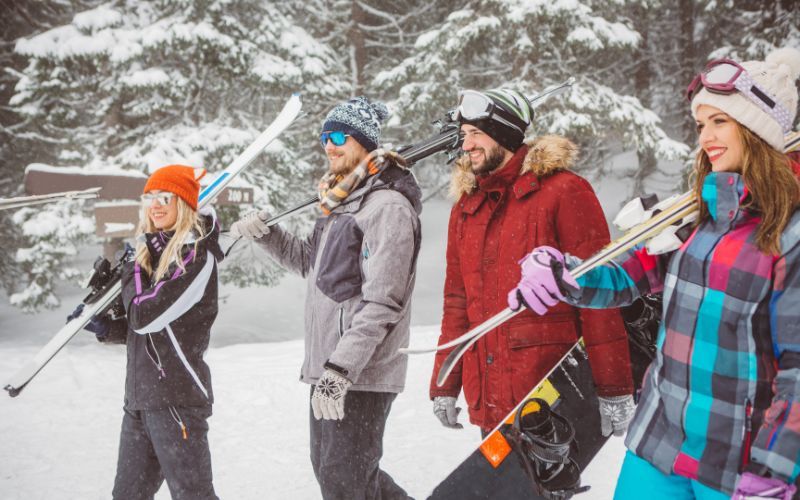
Hiking for Health – Turning Your Hikes into Super Fitness Adventures 2023
Welcome to the world of hiking for health!! If you’ve ever felt the call of the great outdoors and the desire to enhance your physical well-being simultaneously, you’re in for an exhilarating journey. In this blog post, we’re about to embark on a trail of discovery, where we’ll explore how to transform your hikes into fitness adventures. Whether you’re a seasoned hiker or a complete novice, join us as we uncover the benefits, gear essentials, trail selection, and so much more to make your hiking experiences both health-enhancing and unforgettable. Get ready to lace up those hiking boots, because we’re about to step into a world where nature and fitness combine to create a remarkable adventure!!!
Table of Contents
Benefits of Hiking for Fitness – Hiking for health
Hiking is not just a leisurely stroll through nature; it’s a fantastic way to boost your fitness while enjoying the great outdoors. If you’re looking to turn your hikes into fitness adventures, you’re in for a treat. Hiking for health offers a range of incredible benefits that cater to your physical and mental well-being.

1. Cardiovascular Health: Hiking for health gets your heart pumping and your blood flowing. It’s an excellent cardiovascular workout that can help lower your risk of heart disease, improve circulation, and strengthen your heart muscles.
2. Weight Management: If you’re aiming to shed a few pounds or maintain a healthy weight, hiking can be a powerful ally. Trekking on varied terrains burns calories, making it an effective way to support your weight management goals.
3. Muscle Strength: Hiking engages various muscle groups, including your legs, glutes, core, and upper body when navigating steep inclines or uneven trails. Over time, this helps tone and strengthen your muscles.
4. Stress Reduction: Nature has a remarkable ability to reduce stress, and hiking for health provides the perfect escape from the hustle and bustle of daily life. It’s a chance to unplug, clear your mind, and find peace in the natural world.
5. Improved Balance and Coordination: Hiking for health on uneven terrain requires balance and coordination, helping you develop these skills as you go. This can be especially beneficial as you age.
6. Mental Well-being: The combination of physical activity and nature’s tranquility can boost your mood and reduce symptoms of anxiety and depression. It’s like therapy for your mind and soul.
7. Vitamin D: Spending time outdoors exposes you to natural sunlight, which is an excellent source of vitamin D. This vitamin is essential for bone health, immunity, and overall well-being.
8. Social Connection: Hiking can be a group activity, allowing you to connect with friends or meet new people who share your passion for fitness and the outdoors.
Incorporating hiking into your fitness routine can be a fun and rewarding way to achieve your health and wellness goals. Whether you’re a beginner or an experienced hiker, the benefits of hiking for health are abundant, making it a versatile and enjoyable form of exercise.
So, grab your hiking boots, hit the trails, and start turning your hikes into fitness adventures today!
Essential Hiking Gear – Hiking for health
Embarking on a hiking adventure is an exciting way to stay fit and connect with nature. To make the most of your hiking experience, having the right hiking for health gear is essential. Whether you’re a novice hiker or a seasoned trailblazer, here’s a list of must-have gear to ensure a safe and enjoyable journey.

1. Hiking Boots: Invest in a comfortable pair of hiking boots that provide ankle support and grip. Proper footwear ensures you can navigate various terrains with ease and reduces the risk of injuries.
2. Backpack: A well-fitted, comfortable backpack is essential for carrying your gear, water, and snacks. Look for one with adjustable straps and multiple compartments for organization.
3. Navigation Tools: Carry a map, compass, or a GPS device to help you navigate the trails. It’s crucial for staying on the right path, especially on longer hikes or in unfamiliar areas.
4. Clothing Layers: Dress in moisture-wicking, breathable layers to regulate your body temperature. Opt for lightweight, quick-drying materials to stay comfortable in changing weather conditions.
5. Rain Gear: Be prepared for unexpected rain with a lightweight rain jacket and pants. Staying dry is not only more comfortable but also safer in colder weather.
6. Headlamp or Flashlight: If your hike extends into the evening, a reliable headlamp or flashlight is indispensable for visibility and safety.
7. First Aid Kit: Carry a compact first aid kit with essentials like bandages, antiseptic wipes, pain relievers, and blister treatment. It’s wise to be prepared for minor injuries.
8. Water and Hydration: Stay hydrated by carrying an adequate supply of water or a water purification system. Dehydration can be a significant concern on longer hikes.
9. Nutrition: Pack energy-boosting snacks like granola bars, nuts, and dried fruits. These will keep your energy levels up during your hike.
10. Sun Protection: Don’t forget sunscreen, sunglasses, and a wide-brimmed hat to shield yourself from harmful UV rays. Sun protection is crucial, even on cloudy days.
11. Multi-Tool or Knife: A versatile multi-tool or a compact knife can come in handy for various tasks, from food prep to emergency situations.
12. Insect Repellent: Depending on the season and location, insects can be a nuisance. Carry a reliable insect repellent to keep bugs at bay.
13. Personal Identification: Carry your ID, a copy of your hiking itinerary, and emergency contact information in a waterproof bag or pouch.
Having the right hiking gear not only enhances your safety but also ensures that your hiking adventure is enjoyable and stress-free. Before hitting the trail, check the weather forecast and trail conditions to ensure you’re well-prepared. With the right equipment, you’re ready to turn your hikes into fitness adventures and explore the beauty of the great outdoors.
Choosing the Right Hiking Trails – Hiking for health
One of the joys of hiking for health is exploring the natural beauty of different trails. To make the most of your hiking for health adventures, it’s crucial to select the right trails that match your fitness level and goals. Here are some tips to help you choose the perfect hiking trails:

1. Assess Your Fitness Level: Before picking a trail, honestly assess your fitness level. If you’re a beginner or have limited experience, start with shorter, less challenging hikes. More experienced hikers can aim for longer and more strenuous trails.
2. Trail Difficulty: Trails are often categorized as easy, moderate, or difficult. Pay attention to these ratings to match your fitness level. Easy trails are generally flat and well-maintained, while difficult trails may involve steep ascents and rugged terrain.
3. Trail Length: Consider how long you want to hike. Shorter hikes are great for a quick workout, while longer hikes can be a full-day adventure. Plan accordingly and pack enough supplies.
4. Terrain: The type of terrain matters. If you prefer a leisurely walk, choose a trail with a well-defined path. If you seek a challenge, opt for rocky or steep terrain.
5. Elevation Gain: Elevation gain can significantly impact the difficulty of a hike. Research the elevation profile of the trail to understand how much you’ll be ascending and descending.
6. Trail Features: Some trails lead to beautiful viewpoints, waterfalls, or unique natural features. Decide if you’d like specific attractions along your route.
7. Season and Weather: Be mindful of the season and weather conditions. Some trails may be inaccessible or dangerous during certain times of the year. Always check the weather forecast before heading out.
8. Trail Accessibility: Ensure that the trailhead is accessible and has facilities like parking, restrooms, and trail maps.
9. Local Knowledge: Local hikers and online resources can provide valuable insights. Read reviews, join hiking forums, or ask for recommendations from experienced hikers in your area.
10. Safety: Always prioritize safety. Let someone know your hiking plans and estimated return time. Carry essential safety gear like a map, compass, or GPS device.
11. Leave No Trace: Practice responsible hiking by leaving no trace. Respect the environment, pack out your trash, and follow all trail rules.
Remember that the goal of hiking for health is to enjoy the experience while improving your health. Start with trails that match your abilities, and gradually work your way up to more challenging routes as your fitness level increases. With the right trail selection, you can turn your hikes into fulfilling fitness adventures that leave you feeling invigorated and connected to nature.
Incorporating Strength Training – Hiking for health
Hiking is not just about putting one foot in front of the other; it’s also an opportunity to build strength and endurance while enjoying the great outdoors. If you’re looking to take your hiking for health to the next level, consider incorporating strength training exercises into your hiking routine. Here’s how you can do it:
1. Bodyweight Exercises: Hiking trails offer a natural gym for bodyweight exercises. Stop at scenic spots or level areas to perform exercises like squats, lunges, push-ups, and planks. These exercises engage various muscle groups and help improve strength.
2. Trail Terrain: Take advantage of the trail’s natural terrain. Hiking uphill or on uneven terrain automatically engages your leg muscles, especially your quadriceps and calf muscles. Embrace the inclines and declines for a strength-building workout.
3. Hiking with a Backpack: Carrying a loaded backpack while hiking adds resistance to your workout. Start with a comfortable weight and gradually increase it as you build strength. Ensure the backpack is well-balanced for stability.
4. Use Hiking Poles: Hiking poles aren’t just for balance; they also provide an upper body workout. Pushing off with each step engages your arms, shoulders, and chest muscles.
5. Rock and Log Exercises: If you encounter rocks or logs along the trail, use them for step-ups or incline push-ups. These natural obstacles can add variety to your strength training routine.
6. Rest Breaks: During rest breaks, perform exercises like leg lifts or calf raises to target specific muscle groups. These short bursts of activity can enhance your overall fitness.
7. Incorporate Resistance Bands: Lightweight resistance bands are portable and can be easily added to your hiking gear. Use them for resistance exercises like bicep curls or lateral raises during breaks.
8. Core Strengthening: A strong core is essential for stability on the trail. Incorporate exercises like planks, Russian twists, or bicycle crunches during rest stops.
9. Stretching: Don’t forget to stretch after your hike. Incorporating dynamic stretches can help improve flexibility and prevent muscle stiffness.
10. Balancing Exercises: Hiking on uneven terrain naturally challenges your balance. Use this opportunity to improve your balance by walking on narrow trails or tree roots.
Remember, the key to incorporating strength training into your hiking routine is consistency. Start with exercises that match your current fitness level and gradually progress. Whether you’re hiking through forests, ascending mountains, or exploring desert landscapes, your hikes can become full-body workouts that contribute to your overall fitness and stamina. Plus, the stunning views along the way make every workout feel like an adventure.
So, lace up your hiking boots, pack your gear, and get ready to turn your hikes into powerful fitness adventures that leave you feeling strong and invigorated.
Nutrition for Hikers – Hiking for health
Hiking for health is not just about the journey; it’s also about fueling your body for the adventure. Proper nutrition for hikers is essential to maintain energy levels, stay hydrated, and recover effectively. Here’s how to ensure you’re nourishing your body for those exhilarating hikes:
1. Hydration is Key: Start your hike well-hydrated and carry an ample supply of water. Dehydration can lead to fatigue and muscle cramps. Sip water frequently throughout your hike, and consider a hydration reservoir or water purification system for longer journeys.
2. Balanced Snacks: Pack lightweight, energy-dense snacks like trail mix, energy bars, dried fruits, and nuts. These provide a quick energy boost and are easy to consume on the go.
3. Portable Meals: For longer hikes, bring portable, balanced meals. Consider sandwiches, wraps, or salads in a compact container. Opt for whole grains, lean proteins, and plenty of vegetables to keep you fueled.
4. Electrolytes: On hot and sweaty hikes, consider replenishing lost electrolytes with sports drinks or electrolyte tablets. This helps maintain proper muscle function and prevents cramping.
5. Fruit and Veggies: Fresh fruits and vegetables are excellent choices for hikers. They provide essential vitamins and minerals while adding a refreshing element to your snack or meal.
6. Protein for Recovery: Include protein-rich snacks like jerky, cheese, or yogurt to aid in muscle recovery. Protein helps repair and build muscle tissue after a strenuous hike.
7. Avoid Excessive Sugars: While some sugar is fine for a quick energy boost, avoid excessive sugary snacks that can lead to energy crashes. Look for snacks with a balance of carbs, protein, and fats.
8. Timing Matters: Eat regularly to maintain a steady energy level. Snack every 1-2 hours, and have a balanced meal if your hike extends over several hours.
9. Listen to Your Body: Pay attention to hunger and thirst cues. If you’re hungry, refuel. If you’re thirsty, drink water. Your body knows best.
10. Pack Out Waste: Be responsible with your food waste. Pack out all wrappers and leftovers to preserve the natural environment.
11. Plan for Special Diets: If you have dietary restrictions or allergies, plan your hiking nutrition accordingly. There are many options available for gluten-free, vegan, or other specific diets.
12. Post-Hike Recovery: After your hike, refuel with a balanced meal that includes carbs, protein, and healthy fats. This helps replenish energy stores and promotes muscle recovery.
Proper nutrition for hikers is vital not only for your performance but also for your safety. Filling your backpack with the right foods ensures you have the energy and sustenance needed to enjoy the trail to the fullest. So, before your next hike, take a moment to plan your nutrition strategy, and you’ll be well-prepared for an amazing hiking adventure.
Remember, staying well-nourished enhances your hiking experience, making it more enjoyable and rewarding. Happy hiking and happy eating!
Tracking Your Progress – Hiking for health
Turning your hikes into fitness adventures involves not only enjoying the great outdoors but also monitoring your progress along the way. Tracking your fitness journey can be motivating and help you set and achieve your goals. Here’s how to effectively track your progress when hiking for health:
1. Fitness Apps: There’s a plethora of fitness apps available that can help you track your hikes. Apps like Strava, AllTrails, GaiaGPS and MapMyHike allow you to record your route, distance, elevation gain, and even your pace. They also provide insights into your progress over time.
2. GPS Devices: If you prefer a dedicated device, invest in a GPS watch or handheld GPS unit. These devices provide accurate data on your hiking activities, including distance covered and elevation climbed.
3. Pedometers and Fitness Trackers: Wearable fitness trackers or pedometers can count your steps and estimate calories burned during your hikes. They offer a simple way to monitor your activity.
4. Journaling: Keeping a hiking journal allows you to record not just the data but also your feelings and experiences. Note the date, trail, weather conditions, and how you felt during the hike. Over time, you’ll see patterns and improvements.
5. Photos and Milestones: Take photos at key points along your hikes to mark your progress. It’s a visual way to see how far you’ve come. Set milestones, such as conquering a particularly challenging trail or achieving a certain distance.
6. Set Goals: Establish clear fitness goals for your hiking adventures. Whether it’s reaching a specific distance, summiting a particular peak, or hiking a certain number of trails, having goals gives you something to strive for.
7. Share Your Journey: Sharing your progress with friends and the hiking community can be motivating. Post your achievements on social media, join hiking forums, or participate in group challenges.
8. Listen to Your Body: While tracking your progress is important, it’s equally vital to listen to your body. If you’re feeling fatigued or need rest, don’t push yourself too hard. Overtraining can lead to injuries.
9. Adjust Your Strategy: Use the data you collect to adjust your hiking strategy. If you notice improvements, celebrate them and set new goals. If you encounter challenges, adjust your training or seek advice from experienced hikers.
10. Enjoy the Journey: Remember that while tracking progress is valuable, the joy of hiking comes from the experience itself. Don’t get too caught up in the numbers; savor the sights, sounds, and serenity of nature.
11. Stay Consistent: Consistency is key to seeing progress. Make hiking a regular part of your fitness routine to experience long-term improvements in your health and fitness.
By tracking your progress when hiking for health, you not only stay motivated but also gain valuable insights into your abilities and achievements. It’s a satisfying way to witness your growth as a hiker and ensures that each hike is a step forward in your fitness journey.
So, whether you’re aiming to conquer challenging peaks, increase your hiking distance, or simply improve your overall fitness, tracking your progress can help you achieve your goals while relishing the beauty of the outdoors. Happy hiking and happy tracking!
Safety Precautions and Tips – Hiking for health
While hiking for health is an incredible way to enjoy nature and improve your well-being, it’s crucial to prioritize safety on the trails. The great outdoors can be unpredictable, but with the right safety precautions and tips, you can ensure a safe and enjoyable hiking experience:
1. Plan Ahead: Before you hit the trail, research the hike thoroughly. Know the trail’s difficulty level, length, and terrain. Check the weather forecast and trail conditions to prepare accordingly.
2. Share Your Plans: Always let someone know your hiking plans, including your intended route and estimated return time. In case of emergencies, this information can be vital.
3. Carry Essentials: Pack essential items like a map, compass, GPS device, first aid kit, multi-tool, flashlight, and extra clothing. These items can be lifesavers in unexpected situations.
4. Hydration: Stay well-hydrated throughout your hike. Carry enough water and consider a water purification system for longer hikes.
5. Nutrition: Bring sufficient snacks and meals to maintain your energy levels. A well-fueled body is better equipped to handle challenges.
6. Know Your Limits: Be aware of your fitness level and don’t push yourself too hard. Choose trails that match your abilities, and listen to your body. Rest when needed.
7. Hike with a Buddy: Hiking with a companion is safer than hiking alone. If you do hike alone, inform someone of your plans and expected return time.
8. Dress Appropriately: Wear moisture-wicking clothing suitable for the weather. Dress in layers to adapt to changing conditions. Don’t forget sun protection, including sunscreen and sunglasses.
9. Footwear: Invest in sturdy, comfortable hiking boots with good grip. Ill-fitting footwear can lead to discomfort and injuries.
10. Trail Markings: Pay attention to trail markers and signs. Staying on the designated path helps prevent getting lost.
11. Weather Awareness: Be prepared for sudden weather changes. Carry rain gear, warm clothing, and extra layers, especially at higher elevations.
12. Wildlife Caution: Respect wildlife from a distance. Avoid feeding animals, and familiarize yourself with any potential wildlife encounters in the area.
13. Leave No Trace: Follow the principles of Leave No Trace by packing out all trash, staying on designated trails, and avoiding damage to natural surroundings.
14. Emergency Communication: Carry a charged cell phone, but be aware that reception may be limited in remote areas. Consider a satellite communication device for more remote hikes.
15. Stay Calm in Emergencies: If you get lost or injured, try to stay calm. Use your map, compass, or GPS to navigate, and if necessary, signal for help with a whistle or flashlight.
16. Respect Other Hikers: Be courteous to fellow hikers. Yield the trail to those going uphill, keep noise levels down, and maintain a friendly attitude.
Remember that safety is paramount when hiking for health. While the outdoors offer incredible opportunities for adventure and exercise, it’s essential to be prepared for any situation. By following these safety precautions and tips, you can hike with confidence, knowing that you’ve taken the necessary steps to protect yourself and those around you. Stay safe, enjoy your hikes, and relish the beauty of nature responsibly.
Conclusion – Hiking for Health
As we reach the end of our journey through the world of Hiking for Health , it’s evident that hiking offers more than just a walk in the woods. It’s a pathway to better physical and mental well-being, an opportunity to connect with nature, and a chance to challenge and strengthen your body.
Remember, the benefits of hiking for health are plentiful: improved cardiovascular fitness, stronger muscles, reduced stress, and an enhanced sense of well-being. The essential hiking gear ensures you’re well-prepared and comfortable on the trail, while choosing the right hiking trails tailors your hiking experience to your fitness goals and abilities.
Incorporating strength training into your hikes takes your fitness to the next level, making each step more rewarding. Don’t forget the importance of nutrition for hikers to fuel your adventures and stay energized. That’s what Hiking for Health does.
Tracking your progress allows you to see your growth, motivating you to push your boundaries and achieve new heights in your fitness journey. And, of course, always prioritize safety precautions and tips to ensure every hike is a safe and enjoyable adventure. Hiking for Health never underestimates the exercise!!
So, whether you’re chasing mountaintop views, exploring serene forests, or conquering rugged terrain, Hiking for Health offers a holistic approach to fitness that’s both exciting and fulfilling. It’s a way to make every hike count, not just as a journey through nature but as a journey toward a healthier, happier you.
Now, it’s time to put on your hiking boots, embrace the trails, and savor the magic of turning your hikes into powerful fitness adventures. With each step, you’re not just exploring the world; you’re also exploring the incredible capabilities of your body and the boundless beauty of the outdoors. So, go out there, breathe in the fresh air, and make every hike a step toward a healthier, more vibrant you. Happy hiking for health, happy adventuring, and here’s to the incredible journey ahead!
You might also like:
Popular Stories
Newsletter
About me
Meet Dennis, an enthusiast of the great outdoors. For the past 15 years, he’s maintained a daily routine that includes running, hiking, and hitting the gym, embodying a commitment to an active and healthy lifestyle.
Dennis is a true advocate for the joy and rejuvenation that outdoor living can bring.



